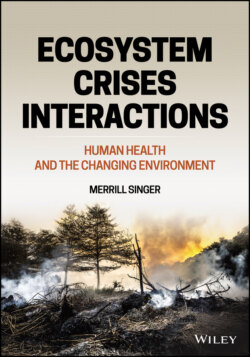Читать книгу Ecosystem Crises Interactions - Merrill Singer - Страница 39
2.3.2.1 Extinction
ОглавлениеNewly discovered species cannot replace those that are being lost as a result of human‐caused ecocrises. These loses are occurring at all scales from local to global. The ecosystem effect of a species extinction is not necessarily tied to its relative abundance. A keystone species (Paine 1966, 1969), like the top predator in an ecosystem food chain, may be relatively rare but play a major role in influencing properties like the pathways of energy and material flows that sustain the system. Within specific ecosystems, the extinction of a species may have limited effect because “(a) ecosystems may have multiple species that carry out similar functional roles, (b) some species may contribute relatively little to ecosystem properties, or (c) properties may be primarily controlled by abiotic environmental conditions” (Hooper et al. 2005, p. 4). Conversely, loss of a single species can have dramatic effects, such as substantial changes in overall community biomass and nutrient cycling (Symstad et al. 1998). Keystone species are critical to an ecosystem because they have low functional redundancy. This means that if the species were to be eliminated, there would be no other species available that could really fill its ecological niche. Consequently, the ecosystem would be forced to change, allowing invasive species to populate and alter the habitat or leading to other consequences due to changes in remaining species populations.
An example of the latter can be seen by looking at Yellowstone National Park as an ecosystem. When the U.S. government designated almost 3500 acres for the park in 1872, there were hundreds of wolves roaming the area, preying especially on large herds of elk and bison. In 1914, fearing the impact of the wolves on those herds, but also on privately owned livestock grazed on public land, Congress appropriated funds to destroy wolves, prairie dogs, and other animals injurious to agriculture and animal husbandry. Park Service hunters carried out these orders, and by 1926 wolves were virtually eliminated from Yellowstone. Loss of this keystone predator started a top‐down trophic cascade. No longer preyed on by the wolves, elk populations exploded and began competing for food resources such as grasses, sedges, and reeds. As a result, these plants did not have time or space to grow. Overgrazing had direct influences on other species, such as fish, beaver, and songbirds, which relied on the plants and their products for survival. Moreover, stream banks began eroding as wetland plants failed to anchor soil and sediments, while lake and river temperatures increased as trees and shrubs failed to provide shaded areas. In the end, it was realized that the complex web of relations that sustained the Yellowstone ecosystem required the presence of wolves, and beginning in the 1990s, in response to a call that began with the biologist Aldo Leopald, the U.S. government began reintroducing them (from Canada). The results have been a shrinking of elk populations, improvements in vegetative cover, and recovery of beaver and songbird populations. According to Doug Smith, a wildlife biologist in charge of the Yellowstone Wolf Project, “[i]t is like kicking a pebble down a mountain slope where conditions were just right that a falling pebble could trigger an avalanche of [positive] change” (quoted in Farquhar 2019).
Unfortunately, this kind of turnaround is not the norm. A recent statistical analysis of 51 bird species currently recorded on the International Union for Conservation of Nature (IUCN) Red List as critically endangered, for example, concluded that eight should be reclassified as already extinct or very close to extinction (Butchart et al. 2018). Stuart Butchart, the principle investigator on the study, explains that: “Ninety per cent of bird extinctions in recent centuries have been of species on islands … However, our results confirm that there is a growing wave of extinctions sweeping across the continents, driven mainly by habitat degradation and disappearance from unsustainable agriculture and logging” (BirdLife International 2018).
Aside from the loss of unique lifeforms, extinctions like these are important because when they occur, they alter key processes needed for the sustainability of Earth’s ecosystems (Loreau et al. 2002; Wardle et al. 2011). Biodiversity loss can undercut the viability of ecosystems by diminishing their ability to respond to environmental change and disruption.
